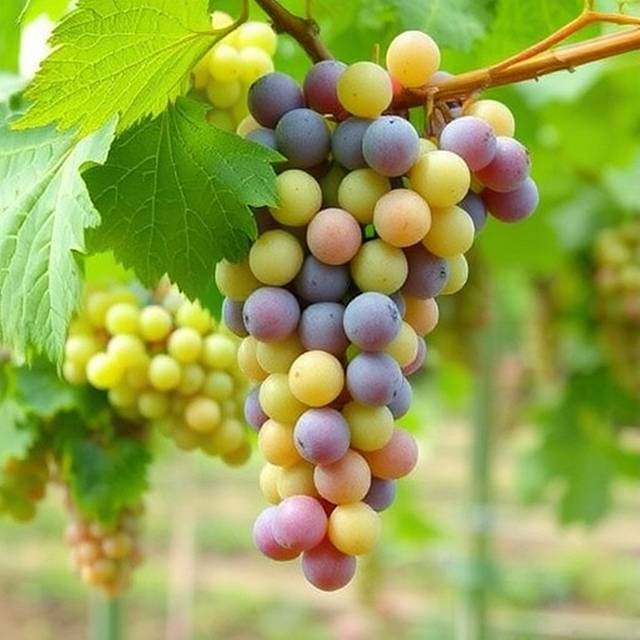Japan Unveils Muscat Shiragai, a New Wine Grape Yielding 41.6 Kilograms in Debut Harvest
Hybrid variety blends rare Shiraga resilience with Muscat aroma, aiming to boost Okayama’s wine industry and regional identity
2025-10-14

Researchers at Okayama University of Science in Japan have announced the successful development of a new wine grape variety called Muscat Shiragai. The announcement follows years of crossbreeding work led by Professor Emeritus Takuji Hoshino, a plant systematics expert and founding director of the university’s Institute of Viticulture and Enology. The project began in 2017 and involved collaboration with Kurashiki City and Funao Winery under a regional revitalization agreement signed in 2018.
Muscat Shiragai is the result of hybridizing the rare wild Shiraga grape, native to the Takahashi River basin in Okayama Prefecture, with the well-known Muscat of Alexandria grape. The Shiraga grape is recognized for its high sugar content, low acidity, and resistance to common grape diseases such as black rot and ripe rot. It is also tolerant to fruit cracking, a trait valued by grape growers. The Muscat of Alexandria, on the other hand, is prized for its aromatic qualities and is widely used in both table grapes and wine production.
The goal of the project was to combine the Shiraga grape’s resilience and unique genetic traits with the Muscat’s flavor profile. Researchers aimed to create a new variety that could thrive in local conditions while offering distinctive sensory characteristics. The project also sought to support regional economic development by creating a grape variety that could become a symbol of Okayama’s terroir and attract wine tourism.
Development of Muscat Shiragai involved extensive experimentation and evaluation. By 2022, several breeding lines were under testing, with researchers measuring sugar accumulation, acidity, pH stability, and conducting sensory analyses. These tests ensured that the new variety would meet both viticultural standards and consumer preferences. In 2024, the final selection was made, and an application for official registration was submitted to Japan’s Ministry of Agriculture, Forestry and Fisheries. The application was accepted, and full registration is expected within four to five years.
The public introduction of Muscat Shiragai took place at a press conference at Okayama University of Science. Attendees included Kurashiki Deputy Mayor Kenji Komatsu, Funao Winery CEO Kenichiro Miyake, and university president Hiroyuki Hirano. Participants sampled both the fresh grapes and wine made from early harvests. The fruit was described as sweet, while the wine showed a delicate Muscat aroma and smooth texture.
Officials expressed optimism about the future of Muscat Shiragai. Deputy Mayor Komatsu emphasized its potential as a regional emblem and noted ongoing research to further improve its qualities. Funao Winery’s CEO Miyake said the winery hopes to establish Muscat Shiragai as a premium brand associated with Kurashiki’s unique terroir. President Hirano highlighted the importance of continued collaboration between academia, industry, and government in supporting agricultural innovation.
Currently, cultivation of Muscat Shiragai is limited to twenty vines each at Funao Winery and the university’s experimental vineyard. These vines produced about 41.6 kilograms of grapes in 2024. Expansion plans are underway, with 300 additional grafted vines planted at the end of 2023. The project aims for production volumes exceeding 500 kilograms between 2028 and 2029. Researchers are also developing vineyard management strategies such as leaf removal, soil fertilization, and irrigation scheduling to optimize grape quality and sustainability.
The Shiraga grape has a long history in Japanese botany, first described in 1918 by Tomitaro Makino and named after Jukichi Shiraga, who discovered it in Niimi City. Its combination of high sugar content, balanced acidity, and disease resistance makes it valuable for breeding programs focused on climate resilience and improved flavor.
Muscat Shiragai demonstrates how integrating wild grape genetics with cultivated varieties can address modern challenges in viticulture. The project serves as an example of how scientific research, local government support, and private industry can work together to create new agricultural products that benefit both biodiversity conservation and regional economies.
As more data becomes available from ongoing vineyard trials, researchers plan to publish detailed studies on Muscat Shiragai’s adaptability, stability, and wine chemistry. These findings are expected to guide best practices for cultivation and winemaking tailored to this new variety.
The development of Muscat Shiragai marks a significant step for Japanese viticulture and may influence grape breeding strategies worldwide as growers seek solutions to climate change and evolving consumer tastes. The project highlights the potential for local biodiversity to drive innovation in agriculture while supporting economic revitalization efforts in rural regions.
Founded in 2007, Vinetur® is a registered trademark of VGSC S.L. with a long history in the wine industry.
VGSC, S.L. with VAT number B70255591 is a spanish company legally registered in the Commercial Register of the city of Santiago de Compostela, with registration number: Bulletin 181, Reference 356049 in Volume 13, Page 107, Section 6, Sheet 45028, Entry 2.
Email: [email protected]
Headquarters and offices located in Vilagarcia de Arousa, Spain.